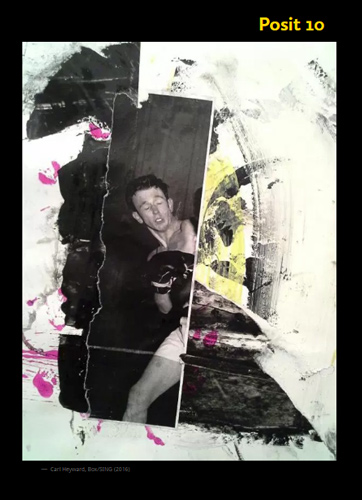Posit – June 2016
Carl Heyward’s “Box/SING” is featured as the cover art for the 10th issue of Posit. The colorful, chaotic mixed media collage has been aptly chosen to greet readers, representing the work found in the new issue: the poetry, prose, and art all sing while pulling no punches.
Carl Heyward’s “Box/SING” is featured as the cover art for the 10th issue of Posit. The colorful, chaotic mixed media collage has been aptly chosen to greet readers, representing the work found in the new issue: the poetry, prose, and art all sing while pulling no punches.
Looking at the table of contents, readers are momentarily kept in the dark. Will clicking a writer’s name bring them to a prose poem, a set of free verse poems, or a short story? Readers can use the Editor’s Note as a quick guide, or like me, they can bypass the summaries in the Note, dive in to the writing, and welcome each surprise as it comes.
I clicked on Becka Mara McKay’s name first, and, incidentally, found my favorite work in the whole issue. McKay weaves figurative language both familiar and insightful in her three-part poem “The Secretary of the Apocrypha Admits to Another Error in Judgment”: “Commands in my language / take on shades of the aurora borealis / but more domestic, like gasoline puddles [ . . . ].” She continues to explore language and language barriers and what this barrier means when it comes to the relationship between the speaker and an unnamed “him”: “I explain // a metaphor (in English): My heart is / a dropped bottle. See it—the splinters, the mess?” Finally, God becomes a metaphor, becomes language. This piece leads seamlessly into the next, “The Secretary of the Apocrypha Finds a Real Job” where, again, language and the existence of a God weave together. If there are more poems in this “Apocrypha” series, I can’t wait to read them.
TJ Beitelman gives a creative twist to each of his three pieces, the inserted italics drawing in the eye before one even reads the writing in full. “The Dream of Flight” reads like a dream, reinventing and rewording itself as it goes:
Or else if not a corridor then at least a regular series of singular points on an otherwise infinite line.
Or not nests: galaxies. A galaxy of inanimate nests. Rough nest of inanimate galaxies. Etc. [ . . . ]
Or not inanimate. Intimate.
This rewriting continues, challenging readers to trace through the lines until we find a semblance of an end.
Randee Silv provides three pieces this issue, “Zero,” “Efficiency,” and “Blending.” Each is only one paragraph long and fragmented. Silv’s bio says she’s an abstract painter who writes how she paints, and Google brought me to graffiti-like paintings: splashes of color and scribbled lines—a perfect visual representation of her written lines like the following from “Blending”:
Left edge. In. Right. Out. I re-walk with brief winding nonchalantly. Lengthiness concise with recorded widths. A hand lifts. A hand falls. Counting segments useless.
Just like Beitelman’s writing, Silv dares us to keep reading and not look away lest we miss something crucial.
The art in this issue grabs attention as well. More of Carl Heyward’s paintings and collages are included in the art section, each work drawing in the eye as all elements are absorbed: paint, glimpses of graph paper, words scribbled in pencil. Among my other favorites in art are Mary DeVincentis’s paintings which suggest innocence with a dark twist, each one telling a story.
The work found inside Posit isn’t always an easy read, but that’s what makes it enjoyable. Challenge yourself with some strong writing this summer and check out all the work inside Issue 10. Watch as it swings punches and listen to it sing.
[www.positjournal.com]






